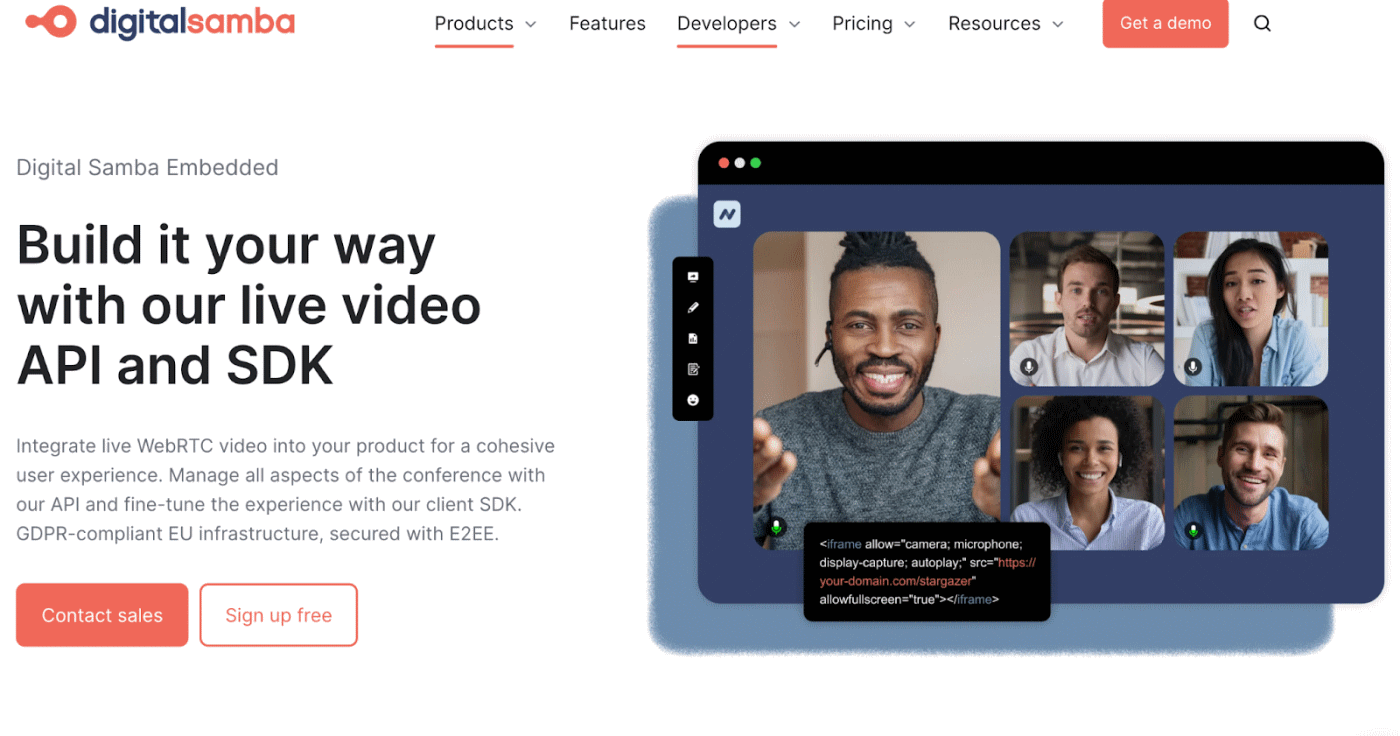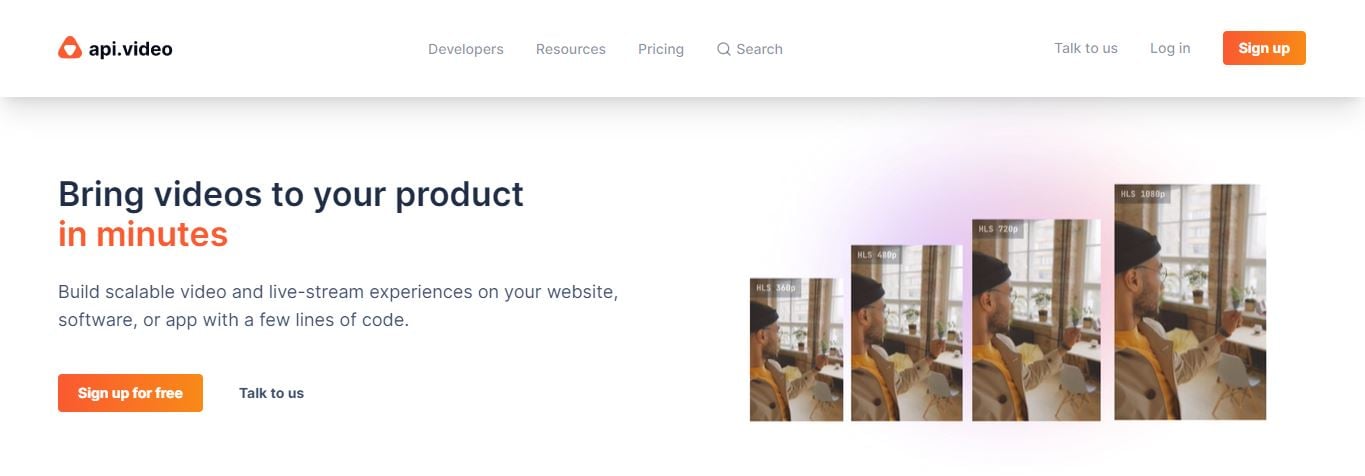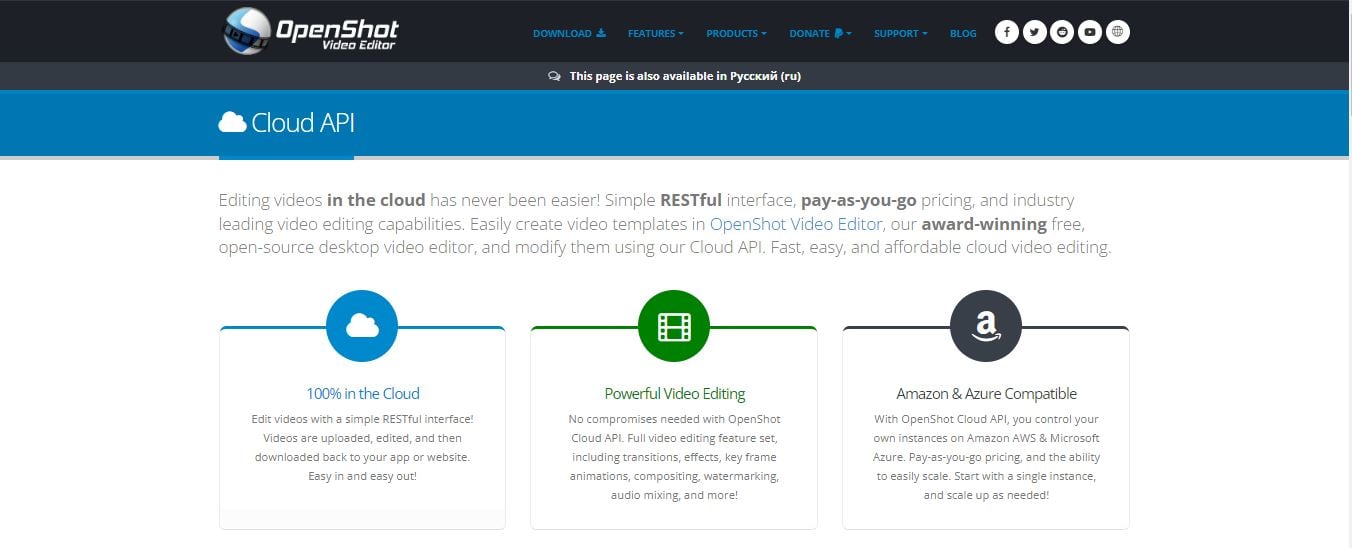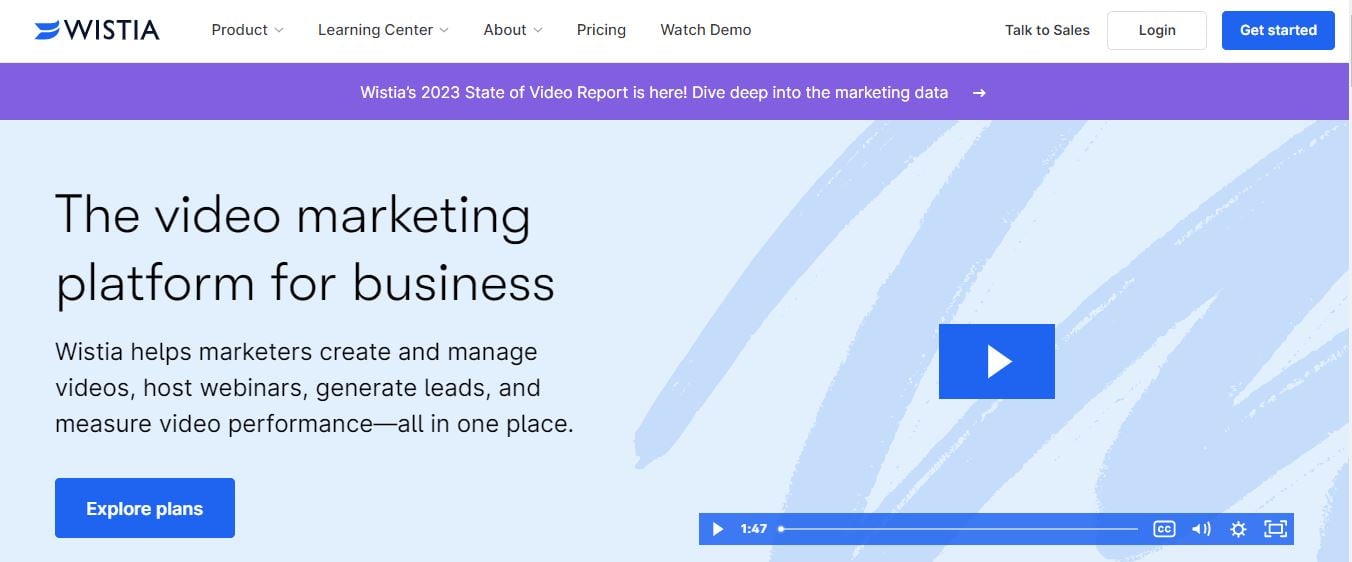What Are The Different Types Of Video API?
For almost every internet user today, video is at the heart of the digital experience. Whether talking to our colleagues in meetings, streaming a movie, or interacting with other people online, video plays a crucial role in shaping our online experience.
Behind the scenes, all of this is possible because of Video APIs that help people manage websites and applications to integrate videos onto their platforms by skipping most of the hassle involved in manual coding.
Table of Contents
- What is a video API?
- Why use Video APIs?
- Benefits of using Video APIs
- Different types of video APIs
- WebRTC APIs
- Video streaming APIs
- Video editing APIs
- Live video streaming APIs
- Video platform APIs
- Client-side video player APIs
- How to choose the right video API for your product?
- Experience smooth streaming with Digital Samba Embedded
Here, we take a detailed look at what video APIs are and how they simplify the process of video integration on websites and applications today.
What Is A Video API?
Take an example
Say you’re a software developer or business integrator tasked with building a video conferencing solution for your organisation. Instead of spending weeks building a video infrastructure from scratch, you can use a video API that provides video conferencing features.
It’ll handle all of the backend infrastructure, including video encoding, streaming, and recording, leaving you free to focus on customising the user interface and integrating the video conferencing solution into your organisation's existing workflows.
So, in essence
A video API allows developers to automate creating, recording, storing, analysing, streaming, and distributing video files. Using Video APIs, custom software developers, integrators, and resellers can quickly integrate video calling into their applications or websites without performing a lot of manual coding, and simply connecting it in a ready-to-use package.
Using Video APIs, software developers, integrators, and resellers can quickly integrate video calling into their applications or websites without performing a lot of manual coding and simply connecting it in a ready-to-use package.
Integrating video APIs can allow end-users to enable live streaming, video conferencing, on-demand video, and other similar kinds of video-based content on their sites and applications.
Different APIs use various protocols and standards for streaming video. Some of these include:
- RTMP (Real-time Messaging Protocol)
- HLS (HTTP Live Streaming)
- MPEG-DASH
Why use video APIs?
The fact is, video-based content is a core part of every user's online experience today. People use it to interact in video chats, view informational videos, stream movies, watch video-based content on social media platforms, and so on.
To make this possible, Video APIs today serve as the foundation for enabling videos on websites and applications across all kinds of use cases. Many apps on your phone or web browser rely on video APIs to enable video viewing.
Because building applications to support videos from scratch is challenging, expensive, and time-consuming, video APIs simplify this process by providing the functionality in a ready-to-use, pre-built package. The result is a development process that is more efficient because of lower resources and time consumption.
Benefits of using Video APIs
The increasing demand for efficient processes to handle video-based content has made Video APIs an essential tool for digital media solutions. Key benefits of Video APIs include:
Easy integration
Video APIs make it possible to easily integrate video content and functionality into existing applications, making it possible to quickly build robust and secure multimedia solutions.
Increased productivity
Video APIs can significantly reduce the time and effort required to build, manage, and deploy video projects by automating tasks.
Improved flexibility
Video APIs enable developers to quickly add new features to bring video content to users, making them an essential tool for software developers and integrators.

Lower cost
Video APIs reduce the cost of development, maintenance, and storage and are especially useful for small businesses that may need more resources to build a complete video infrastructure from scratch.
Scalability
Video APIs can handle large amounts of video data and traffic, making them scalable to meet the needs of growing applications and businesses.
Improved security
APIs can help ensure the security of your video content with encryption algorithms and other security measures. This is especially important for companies that handle sensitive video data, provide services in regulated industries, and have to comply with regulatory frameworks such as GDPR or CCPA.
Different types of video APIs
Several different types of video APIs are available for developers, each with unique features and capabilities. Here are some of the most common types of video APIs:
WebRTC APIs
WebRTC APIs have become extremely popular for developers creating real-time communication applications. In addition to providing high-quality video and audio, WebRTC APIs offer several other benefits.
One of the key advantages of this API is its support for end-to-end encryption (E2EE). This ensures that all communication between two peers is secure and private since the data is encrypted before it leaves one device and decrypted upon arrival at the other.
In addition to E2EE, it also facilitates peer-to-peer connections. As a result, there is no need for intermediaries or a centralised server, which can significantly reduce latency. This makes WebRTC APIs well-suited for applications that require real-time communication and minimal delays.
Example: Digital Samba Embedded

Video streaming APIs
Video streaming APIs are great for developers looking to add streaming features to their products or applications. These APIs allow developers to quickly and efficiently implement an end-to-end video streaming solution without building it from scratch.
Use cases for video streaming APIs include live streaming of events, video-on-demand services, and video hosting platforms.
Many streaming APIs offer various features, including real-time analytics, content delivery networks (CDNs), adaptive bitrate streaming, and support for multiple video formats.
Additionally, many provide access to the underlying media player so that developers can customise the appearance and functionality of their video players.
Example: api.video

Video editing APIs
Video editing APIs provide developers with an easy way to create and manage video content. These APIs enable developers to quickly edit and render multiple videos on the cloud, optimising them for delivery on demand.
These APIs come equipped with features that make the process easier and more efficient, such as the ability to crop, resize, and apply effects to videos. Additionally, they often provide support for audio editing as well.
Most video editing APIs also include integration with 3rd party hosting providers, meaning that developers can quickly deploy their content on the web or through a mobile device.
Example: open shot cloud

Live video streaming APIs
Live video streaming APIs enable developers to create, manage, and broadcast live video streams with minimal effort. These APIs provide all the necessary tools for capturing, encoding and broadcasting live video data in real-time.
Live streaming APIs can handle multiple video streams, support different video formats, and provide access to the underlying media player.
Many live streaming APIs offer features like secure streaming and real-time analytics. Real-time analytics can gain valuable insights into user behaviour, allowing developers to enhance their services accordingly.
Example: MUX
Video platform APIs
Video platform APIs provide a comprehensive solution for managing and delivering video content. These APIs typically include features such as on-demand streaming, live streaming, monetisation, content management systems (CMS), and searchable catalogues.
Video Platform APIs have two main types, which include:
Proprietary video platform API
The proprietary video platform API is an extension of the main product and provides access to platform features, but doesn't allow customisation. This API enables developers to quickly integrate with an existing online video platform, giving them access to its advanced features.
In simpler words, a proprietary API allows developers to reduce development time and get up and running quickly without building their streaming solution from the ground up.
Example: Youtube
Customisable video platform API
This API is different from proprietary ones in that it allows for greater customisation of the platform's features. Developers can modify and extend the core functionality, creating unique experiences tailored to their needs.
Businesses often use this type of API to create a fully branded, customised video platform. Customisations might include a custom-branded video player, advertising capabilities, and complete control over monetisation options.
Example: wistia

Client-side video player APIs
Client-side video player APIs are designed to run on the client side, which means they are executed in the user's browser or device operating system.
When a user visits a web page or opens an application containing video content, the client-side video player API renders the video player. It handles user interactions such as play, pause, seek, and volume adjustments. This allows developers to focus on building their applications' core features without worrying about the complexities of video playback.
Example: Media Source Extension
How to choose the right video API for your product?
Functionality
Determine the specific features and functionality that your product requires, such as video playback, live streaming, video editing, or other advanced capabilities. Choose an API that offers these features and can easily integrate with your existing systems.
Scalability
Consider your product's expected growth and the potential increase in video traffic. Opt for an API that can handle the expected load and scale seamlessly as your product expands.
Pricing
Look for a video API that offers transparent pricing without hidden fees or surprises. Go for a pricing model that aligns with your product's needs based on usage, bandwidth, or other metrics.
Security and compliance
Ensure the API offers robust security features such as end-to-end encryption and complies with privacy regulations such as GDPR. Your users' data must always be protected, so choosing an API that prioritises security and compliance is essential.

The Digital Samba Security White Paper
Download now
Support and documentation
Find an API that offers comprehensive documentation, developer tools, and a responsive support team. These resources will help you integrate the API quickly and troubleshoot any issues that may arise.
Experience smooth streaming with Digital Samba Embedded
Our video API provides a comprehensive set of features and resources designed to make it easier and more efficient for developers to add live video conferencing capabilities to their products.
Our easy-to-use Client SDK helps developers customise their user experience with powerful tools that provide real-time analytics, session recording, and more. With GDPR-compliant EU infrastructure and E2EE encryption for content protection, security is at the core of Digital Samba's product offering.
Get started with Digital Samba’s conference calling API today! With our secure infrastructure and robust feature set, your product will quickly be ready for live conferencing!
Share this
You May Also Like
These Related Stories

What is Digital Samba Embedded

Discover the Top 7 Video Conferencing SDK Vendors of 2025


